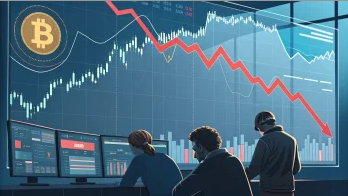Last week, the S&P 500 experienced its best week since November 2022, with an increase of 6%. However, this impressive growth may not necessarily indicate a flourishing market. Despite the positive numbers, there could be several reasons to be cautious in the investment landscape. This article will dissect the reasons behind the recent rally, and discuss their potential implications on the market.
View this post on Instagram
A post shared by Taylor Sohns- CFP®, CIMA®, MBA- Finance (@lifegoalinvestments)
Table of Contents
ToggleReason 1: Oversold Levels in the S&P 500
The first factor contributing to the S&P 500’s bounce was that it had reached “oversold” levels. To understand this concept, we must first familiarize ourselves with the Relative Strength Index (RSI). This technical indicator compares the magnitude of recent gains and losses over a specified period to measure speed and change of price movements.
When the RSI hits 30 or below, an asset is considered “oversold,” indicating that it may be undervalued and due for a price correction. In this case, the S&P 500 reached an RSI value of 30 and sharply rebounded. This suggests that the market, on a technical level, was ready for a recovery after a period of decline. However, as we will see in the subsequent sections, the reasons behind this recovery may not necessarily be positive for the market’s long-term health.
Reason 2: Bad News Equals Good News
The second reason behind the S&P 500 surge ties into the idea that, in the current state of the market, bad news can sometimes be viewed as good news. This concept may seem counterintuitive, but it focuses on the relationship between negative economic data and the potential actions of the Federal Reserve.
Two key instances of this “bad news is good news” phenomenon appeared last week:
a) Weak PMI Data: Two significant economic indicators, the Purchasing Managers’ Indexes (PMIs) for manufacturing and services, reported disappointing results. The manufacturing PMI showed that a decline in car buying was weighing down production. Meanwhile, the services PMI indicated that consumers’ entertainment spending was being impacted by increasing credit card interest rates.
b) Disappointing Job Growth: On Friday, the US Bureau of Labor Statistics revealed that the number of jobs added in October was lower than expected. This news implies that the labor market may not be as strong as previously thought.
Market Reactions: Both developments point to a potentially weaker economy, which one might anticipate would negatively affect stocks. However, the market responded positively to these announcements, rallying in response to the news. This counterintuitive reaction is explained by the idea that a weaker economy might make it easier for the Federal Reserve to control inflation.
The Federal Reserve’s Mandate: The Federal Reserve is responsible for maintaining price stability, along with promoting maximum employment. If economic data demonstrates a faltering economy, the Fed may implement more accommodative policies. This could result in lower interest rates and additional stimulus measures in an attempt to rejuvenate the economy. In turn, these actions often catalyze stock market gains, as lower interest rates can incentivize stock investment.
The Drawbacks of Rallies on Weak Data
As the market saw a positive response to weak data, many may wonder about the consequences of such rallies and whether they should participate in the buying frenzy. Here are some reasons to approach these rallies cautiously.
1) Unsustainable Gains: Rallies built on negative news might be temporary and not indicative of future market performance. A market rebounding from technical indicators like the RSI can produce short-lived gains, giving investors a false sense of security about their investments.
2) Delayed Reactions: The market’s optimistic response to negative news could change as more economic data becomes available or if different interpretations of the data arise. For instance, if this disappointing jobs report becomes part of a larger trend, it could prompt a more significant correction in stock prices.
Conclusion
In summary, the recent S&P 500 rally was built on oversold conditions and an anomalous market reaction to weak economic data. While it may be tempting to invest in stocks during these temporary rebounds, investors should exercise caution and consider the potential downsides of such rallies.
Stay informed about the ever-changing financial landscape by following daily market updates. Being a knowledgeable investor means having a better understanding of the contexts and implications of market events, which can lead to more informed decision-making and, ultimately, more successful investing outcomes.
Frequently Asked Questions: Stocks on November 6, 2023
What contributed to the recent S&P 500 rally?
The recent S&P 500 rally occurred due to a combination of oversold conditions, as indicated by the Relative Strength Index (RSI), and an anomalous market reaction to weak economic data. The market responded positively to disappointing Purchasing Managers’ Indexes (PMI) and job growth news, believing that these factors could encourage the Federal Reserve to implement more accommodative policies to support the economy.
What is the “bad news is good news” phenomenon?
The “bad news is good news” phenomenon occurs when the market responds positively to negative economic data due to its potential impact on the actions of the Federal Reserve. Investors may view bad news as good news because it could make it easier for the Fed to control inflation and maintain price stability, ultimately leading to lower interest rates and additional stimulus measures that support stock market gains.
What are the risks associated with rallies built on weak data?
Rallies built on weak data can be risky for several reasons. First, they can lead to unsustainable gains, as market rebounds based on technical indicators may produce short-lived results that create a false sense of security for investors. Second, the market’s initial optimistic response to negative news can change when more economic data becomes available or different interpretations of the data arise, potentially causing a more significant correction in stock prices.
How can investors make more informed decisions during these temporary rebounds?
Investors should exercise caution during temporary rebounds by staying informed about the ever-changing financial landscape and following daily market updates. By understanding the contexts and implications of market events, investors can make more informed decisions about their investments, leading to more successful outcomes in the long run.

















